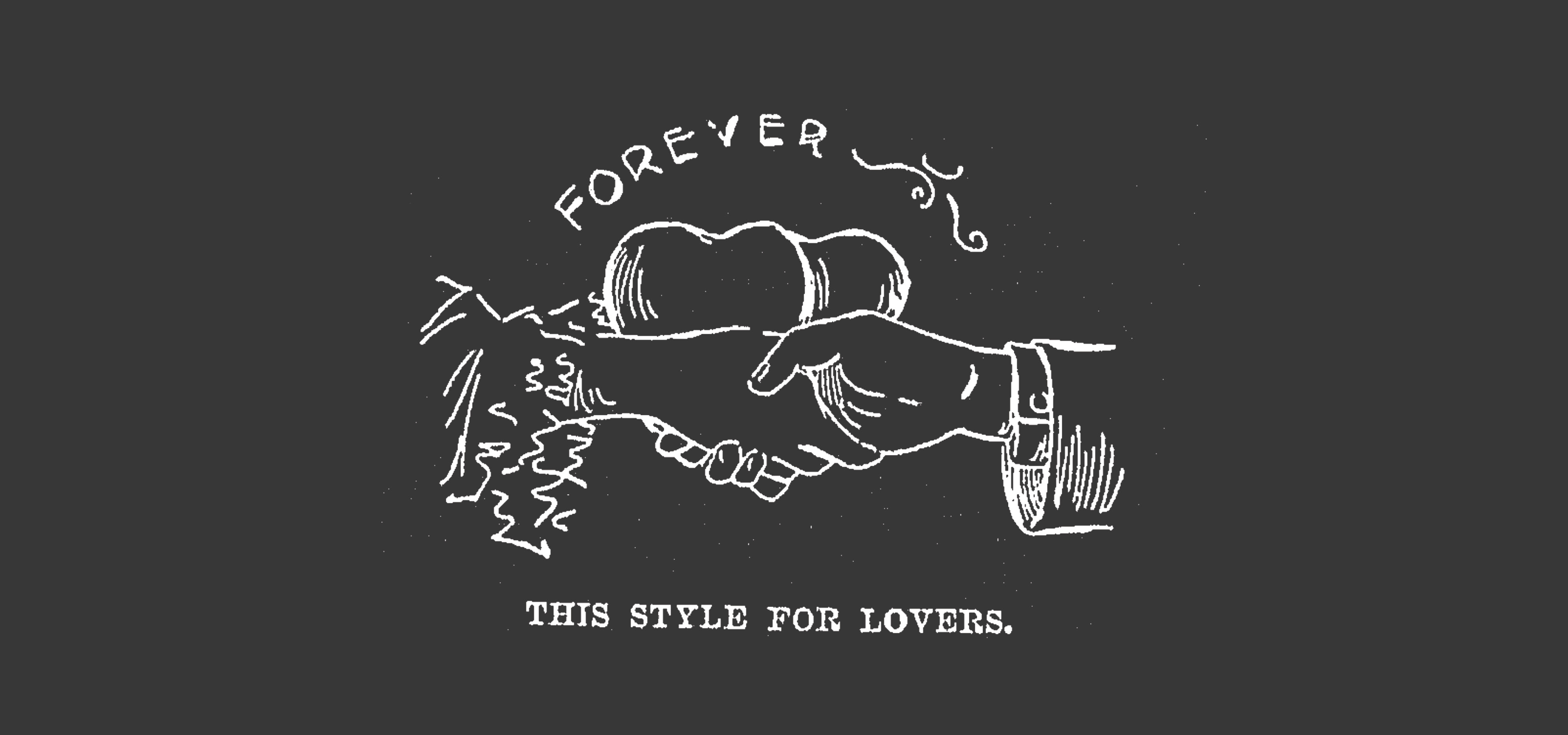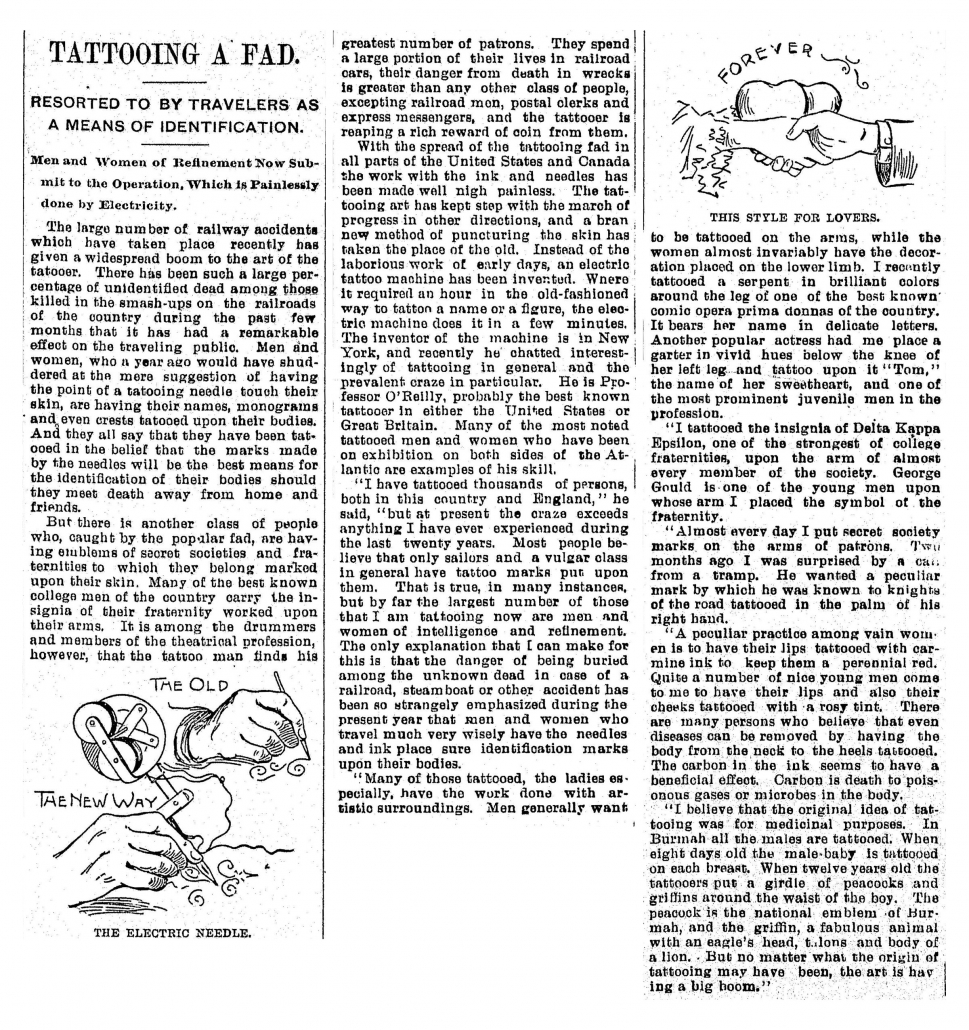Found in the Huron Digitized Newspapers
You never know what curiosity you’ll discover when searching the Digitized Newspaper Collection. Take this article on the tattooing craze in 1896 for example. This article suggests that the recent boom in the tattoo industry has been brought about by an increase in railroad accidents leaving unidentified dead in their wake. A fantastic read indeed!
Excerpt from the Exeter Advocate, 1896-4-30 page 7
Tattooing A Fad
Resorted to by travelers as a means of identification.
Men and women of refinement now submit to the operation, which is painlessly done by electricity.
The large number of railway accidents which have taken place recently has given a widespread boom to the art of the tattooer. There has been such a large percentage of unidentified dead among those killed in the smash-ups on the railroads of the country during the past few months that it has had a remarkable effect on the traveling public. Men and women, who a year ago would have shuddered at the mere suggestion of having a tattooing needle touch their skin, are having their names, monograms, and even crests tattooed upon their bodies. And they all say that they have been tattooed in the belief that the marks made by the needles will be the best means for the identification of their bodies should they meet death away from home and friends.
But there is another class of people who, caught by the popular fad, are having emblems of secret societies and fraternities to which they belong marked upon their skin. Many of the best known college men of the country carry the insignia of their fraternity worked upon their arms. It is among the drummers and members of the theatrical profession, however, that this tattoo man finds his greatest number of patrons. They spend a large portion of their lives in railroad cars, their danger from death in wrecks is greater than any other class of people, excepting railroad men, postal clerks and express messengers, and the tattooer is reaping a rich reward for coin from them.
With the spread of the tattooing fad in all parts of the United States and Canada the work with the ink and needles has been made well nigh painless. The tattooing art has kept step with the march of progress in other directions, and a brand new method of puncturing the skin has taken the place of the old. Instead of the laborious work of early days, an electric tattoo machine has been invented. Where it required an hour in the old-fashioned way to tattoo a name or figure, the electric machine does it in a few minutes. The inventor of the machine in in New York, and recently he chatted interestingly of tattooing in general and the prevalent craze in particular. He is Professor O’Reilly, probably the best known tattooer in either the United States or Great Britain. Many of the most noted tattooed men and women who have been on exhibition on both sides of the Atlantic are examples of his skill.
“I have tattooed thousands or persons, both in this country and England,” he said, “but at present the craze exceeds anything I have ever experienced during the last twenty years. Most people believe that only sailors and a vulgar class in general have tattoo marks put upon them. That is true, in many instances, but by far the largest number of those that I am tattooing now are men and women of intelligence and refinement. The only explanation that I can make for this is that the danger of being buried among the unknown dead in case of a railroad, steamboat or other accident has been so strangely emphasized during the present year that men and women who travel much very wisely have the needles and ink place sure identification marks upon their bodies.
“Many of those tattoos, the ladies especially, have the work done with artistic surroundings. Men generally want to be tattooed on the arms, while the women almost invariably have the decoration placed on the lower limb. I recently tattooed a serpent in brilliant colors around the leg of one of the best known comic opera prima donnas of the country. It bears her name in delicate letters. Another popular actress had me place a garter in vivid hues below the knee of her left leg and tattoo upon it “Tom” the name of her sweetheart, and one of the most prominent juvenile men in the profession.
“I tattooed the insignia of Delta Kappa Epsilon, one of the strongest of college fraternities, upon the arm of almost every member of the society. George Gould is one of the young men upon whose arm I placed the symbol of the fraternity.
“ Almost every day I put secret society marks on the arms of patrons. Two months ago I was surprised by a call from a tramp. He wanted a peculiar mark by which he was known to knights of the road tattooed in the palm of his right hand.
“A peculiar practice among vain women is to have their lips tattooed with carmine ink to keep them perennial red. Quite a number of nice young men come to me to have their lips and also their cheeks tattooed with a rosy tint. There are many persons who believe that even diseases can be removed by having the body from the neck to the head tattooed. The carbon in the ink seems to have a beneficial effect. Carbon is death to poisonous gases or microbes in the body.
“I believe that the original idea of tattooing was for medical purposes. In Burmah all the males are tattooed. When eight days old the male baby is tattooed on each breast. When twelve years old the tattooers put a girdle of peacocks and griffins around the waist of the boy. The peacock is the national emblem of Burmah, and the griffin, a fabulous animal with an eagle’s head, talons and a body of a lion. But no matter what the origin of tattooing may have been the art is having a big boom.”


